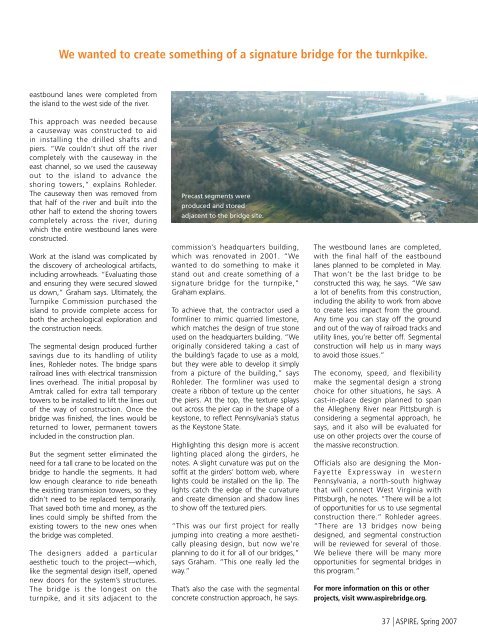ASPIRE Spring 07 - Aspire - The Concrete Bridge Magazine
ASPIRE Spring 07 - Aspire - The Concrete Bridge Magazine
ASPIRE Spring 07 - Aspire - The Concrete Bridge Magazine
You also want an ePaper? Increase the reach of your titles
YUMPU automatically turns print PDFs into web optimized ePapers that Google loves.
We wanted to create something of a signature bridge for the turnkpike.<br />
eastbound lanes were completed from<br />
the island to the west side of the river.<br />
This approach was needed because<br />
a causeway was constructed to aid<br />
in installing the drilled shafts and<br />
piers. “We couldn’t shut off the river<br />
completely with the causeway in the<br />
east channel, so we used the causeway<br />
out to the island to advance the<br />
shoring towers,” explains Rohleder.<br />
<strong>The</strong> causeway then was removed from<br />
that half of the river and built into the<br />
other half to extend the shoring towers<br />
completely across the river, during<br />
which the entire westbound lanes were<br />
constructed.<br />
Work at the island was complicated by<br />
the discovery of archeological artifacts,<br />
including arrowheads. “Evaluating those<br />
and ensuring they were secured slowed<br />
us down,” Graham says. Ultimately, the<br />
Turnpike Commission purchased the<br />
island to provide complete access for<br />
both the archeological exploration and<br />
the construction needs.<br />
<strong>The</strong> segmental design produced further<br />
savings due to its handling of utility<br />
lines, Rohleder notes. <strong>The</strong> bridge spans<br />
railroad lines with electrical transmission<br />
lines overhead. <strong>The</strong> initial proposal by<br />
Amtrak called for extra tall temporary<br />
towers to be installed to lift the lines out<br />
of the way of construction. Once the<br />
bridge was finished, the lines would be<br />
returned to lower, permanent towers<br />
included in the construction plan.<br />
But the segment setter eliminated the<br />
need for a tall crane to be located on the<br />
bridge to handle the segments. It had<br />
low enough clearance to ride beneath<br />
the existing transmission towers, so they<br />
didn’t need to be replaced temporarily.<br />
That saved both time and money, as the<br />
lines could simply be shifted from the<br />
existing towers to the new ones when<br />
the bridge was completed.<br />
<strong>The</strong> designers added a particular<br />
aesthetic touch to the project—which,<br />
like the segmental design itself, opened<br />
new doors for the system’s structures.<br />
<strong>The</strong> bridge is the longest on the<br />
turnpike, and it sits adjacent to the<br />
Precast segments were<br />
produced and stored<br />
adjacent to the bridge site.<br />
commission’s headquarters building,<br />
which was renovated in 2001. “We<br />
wanted to do something to make it<br />
stand out and create something of a<br />
signature bridge for the turnpike,”<br />
Graham explains.<br />
To achieve that, the contractor used a<br />
formliner to mimic quarried limestone,<br />
which matches the design of true stone<br />
used on the headquarters building. “We<br />
originally considered taking a cast of<br />
the building’s façade to use as a mold,<br />
but they were able to develop it simply<br />
from a picture of the building,” says<br />
Rohleder. <strong>The</strong> formliner was used to<br />
create a ribbon of texture up the center<br />
the piers. At the top, the texture splays<br />
out across the pier cap in the shape of a<br />
keystone, to reflect Pennsylvania’s status<br />
as the Keystone State.<br />
Highlighting this design more is accent<br />
lighting placed along the girders, he<br />
notes. A slight curvature was put on the<br />
soffit at the girders’ bottom web, where<br />
lights could be installed on the lip. <strong>The</strong><br />
lights catch the edge of the curvature<br />
and create dimension and shadow lines<br />
to show off the textured piers.<br />
“This was our first project for really<br />
jumping into creating a more aesthetically<br />
pleasing design, but now we’re<br />
planning to do it for all of our bridges,”<br />
says Graham. “This one really led the<br />
way.”<br />
That’s also the case with the segmental<br />
concrete construction approach, he says.<br />
<strong>The</strong> westbound lanes are completed,<br />
with the final half of the eastbound<br />
lanes planned to be completed in May.<br />
That won’t be the last bridge to be<br />
constructed this way, he says. “We saw<br />
a lot of benefits from this construction,<br />
including the ability to work from above<br />
to create less impact from the ground.<br />
Any time you can stay off the ground<br />
and out of the way of railroad tracks and<br />
utility lines, you’re better off. Segmental<br />
construction will help us in many ways<br />
to avoid those issues.”<br />
<strong>The</strong> economy, speed, and flexibility<br />
make the segmental design a strong<br />
choice for other situations, he says. A<br />
cast-in-place design planned to span<br />
the Allegheny River near Pittsburgh is<br />
considering a segmental approach, he<br />
says, and it also will be evaluated for<br />
use on other projects over the course of<br />
the massive reconstruction.<br />
Officials also are designing the Mon-<br />
Fayette Expressway in wester n<br />
Pennsylvania, a north-south highway<br />
that will connect West Virginia with<br />
Pittsburgh, he notes. “<strong>The</strong>re will be a lot<br />
of opportunities for us to use segmental<br />
construction there.” Rohleder agrees.<br />
“<strong>The</strong>re are 13 bridges now being<br />
designed, and segmental construction<br />
will be reviewed for several of those.<br />
We believe there will be many more<br />
opportunities for segmental bridges in<br />
this program.”<br />
For more information on this or other<br />
projects, visit www.aspirebridge.org.<br />
37 | <strong>ASPIRE</strong>, <strong>Spring</strong> 20<strong>07</strong>

















